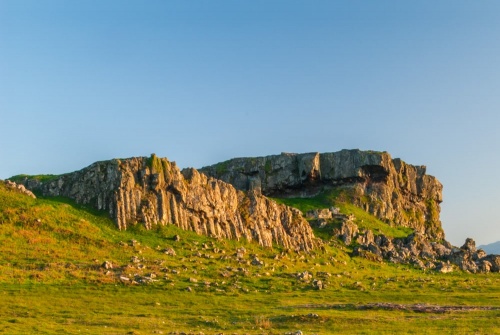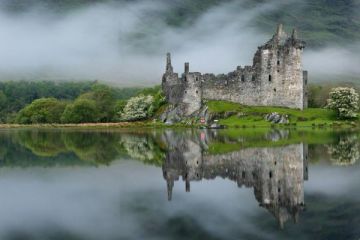
Atop high cliffs at Dunagoil in the southwestern corner of Bute is an intriguing Iron Age hill fort, with a second, smaller fort nearby and a burial cist in between the two forts. Dunagoil Hill Fort stands at the southern end of Dunagoil Bay, a short distance away from the ruins of St Blane's Church and Monastery.
Other prehistoric features at Dunagoil include middens, remains of rig-and-furrow cultivation, a possible timber roundhouse site, and clearance cairns.
The stone ramparts of the hill fort have been vitrified, or melted by intense heat. There are no obvious features inside the fort.

The name Dunagoil comes from the same root as the Irish place name Donegal, from the Celtic words dun na gall, meaning the hill of the foreigners.
The fort is defended by a single stone wall up to 3.5m (11.5 feet) thick that encircles the summit of a natural hill of volcanic basalt overlooking the foreshore. On the seaward side, the wall shows clear signs of vitrification. Pieces of vitrified stone appear in the landward (east) wall, suggesting that it was repaired using vitrified stone from the seaward wall.
There are vertical cliffs on the northeast and northwest of the basalt ridge, with the fort at 35m above sea level. These cliffs mean that Dunagoil is sometimes described as a 'cliff fort'. To the southeast, the ground slopes away gradually to a cove. To the north and east, the approach is defended by a drystone wall that still stands up to 1m (3 feet) high, creating an outer enclosure, or bailey.

The fort is roughly 300 feet x 75 feet (91m x 23m). An investigation by the Ordnance Survey Archaeology Division concluded that the stone wall was supported by timber posts, which caught fire, destroying the wall. The fort was repaired and reoccupied, with a new cross-wall creating a smaller enclosure on the summit. The most obvious vitrified section of the wall is in the northwest corner. You can also see pieces of vitrified stone that have fallen down the slope.
There is an 8-foot-wide (2.5m) gap on the south side, now filled with loose stones, suggesting an entrance.

Archaeologists investing Dunagoil found a wealth of artefacts including a Bronze Age stone mould, polished stone axe heads, an Iron Age brooch, glass and lignite bracelets, crucibles, bronze and iron ring-headed pins, a wealth of broken pottery, and spindle whorls. These finds are now held at the Rothesay Museum.
Closer to the beach of Dunagoil Bay is Little Dunagoil Fort. This is much less impressive than its larger neighbour. On the low ground roughly halfway between the two hill forts is a stone-lined burial cist.

Getting There
The easiest way to reach Dunagoil Hill Fort is to take the minor road known as Plan Road that leads to St Blane's Church and park at the free parking area at the end of the road. Dunagoil Fort is clearly visible to the west, about 600m away.
I spent several happy evenings photographing the sunset from the volcanic foreshore of Dunagoil Bay, under the shadow of Dunagoil Hill Fort. It is one of those places that seems to have an air of something special about it. The location is sublime, the scenery unforgettable.

Please note that there are no visitor facilities at Dunagoil, and no information panels to give a better understanding of the site
The Royal Commission on the Ancient and Historical Monuments of Scotland (RCAHMS) calls Dunagoil an 'iconic site', and I can wholeheartedly endorse that description.
About Dunagoil Hill Fort
Address: Dunagoil,
Kingarth,
Bute,
Argyll and Bute,
Scotland, PA20 9LX
Attraction Type: Prehistoric Site
Location: At the end of the minor road from Kingarth to St Blane's, on the high cliffs overlooking the shore south of Dunagoil Bay
Website: Dunagoil Hill Fort
Location
map
OS: NS085531
Photo Credit: David Ross and Britain Express
NEARBY HISTORIC ATTRACTIONS
Heritage Rated from 1- 5 (low to exceptional) on historic interest
St Blane's Church - 0.6 miles (Historic Church) ![]()
Stravanan Bay Stone Row - 1.4 miles (Prehistoric Site) ![]()
Kelspoke Castle - 1.5 miles (Castle) ![]()
Blackpark Standing Stones - 1.7 miles (Prehistoric Site) ![]()
Glencallum Bay Lighthouse - 1.9 miles (Historic Building) ![]()
Scalpsie Bay and Seals - 3.7 miles (Countryside) ![]()
Mount Stuart - 4.2 miles (Historic House) ![]()
St Ninian's Chapel - 5.9 miles (Historic Church) ![]()
Nearest Holiday Cottages to Dunagoil Hill Fort:
Nearby accommodation is calculated 'as the crow flies' from Dunagoil Hill Fort. 'Nearest' may involve a long drive up and down glens or, if you are near the coast, may include a ferry ride! Please check the property map to make sure the location is right for you.
More self catering near Dunagoil Hill Fort



